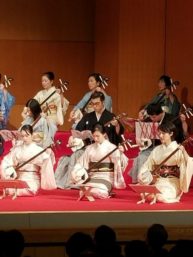My CIP from last semester culminated into four days of policy building on the sustainability of journalism at the All Japan Model United Nations Conference over winter break. As I returned for a second semester of KCJS, I decided to change my CIP from a school activity to a more volunteer-based project. Thus, I began tutoring English through a previous host mother’s ECC English class.
After nearly five months of non-stop Japanese lessons, becoming an instructor rather than a student was certainly a change, as was speaking English in a classroom setting. However, I powered through and worked to instruct to my best ability despite realizing that living in Japan had managed to erode my grammatical skills.
I had previously spent a summer in Kyoto as a high school sophomore, nearly five years ago now. I stayed with a small host family just west of Doshisha while commuting to a Japanese language school daily. I’d kept in touch over the past few years, and when I reached out to ask if my host mother would be willing to accept a volunteer assistant teacher, she seemed excited. We met in January to discuss lessons plans, games to play with students and how to prepare them for an ominous upcoming English conversation test in February. I returned the next week to begin helping run classes.
Over my time at ECC I worked with a variety of students, ranging from second year elementary schoolers to third year middle schoolers. I was incredibly impressed by all of their dedication, many arriving to English lessons after both regular school and juku cram school. They did their best each lesson and honestly inspired me to work a bit harder myself.
A typical lesson would last a little over an hour. Students would come in and warm up with a short conversation exercise, like stating their favorite sweets, sports, or season. We’d then begin work from their textbooks, typically covering a conversation piece followed by a series of questions detailing the scene. We also sang quite a few songs and played more interactive games like ‘Simon Says” or ‘Heads Up.’ Finally we’d go over homework and prepare for the upcoming speaking text before going home.
I was surprised by how rigid the language study was. Even organic activities like playing games or speaking about weekend plans seemed carefully scripted. Perhaps most rehearsed was interview test prep. Students were expected to introduce themselves by name and then reveal exactly three facts about themselves. Acceptable facts were outlined to include school, hometown, age, and favorite sport. The students would then respond to a few prepared questions (What time do you go to bed? Do you like steak? Etc.) Before pointing to certain objects in a picture.
I was struck by the differences in this language study and my own experience learning Japanese. I began taking Japanese classes in high school, and despite being twice the age of some of the ECC students, remember playing far more games and interacting naturally albeit in fractured Japanese. As I result, I gained far more confidence with Japanese, seeing it as a free-flowing language rather than a series of acceptable answers and responses. The difference was apparent. Simply changing questions slightly (What time do you wake up? Do you like sushi?) rather than the previous questions seemed to stump students. I began to more clearly see the cultural pattern of Japanese adults who have spent multiple years learning English yet shy away from foreigners. Learning English in a series of set phrases is relatively easy, but any change to the existing structure tends to leave you reeling.
I have to say that interacting with the students was challenging at first. Most of them were incredibly surprised to see me (very distinctively not Japanese) in the classroom and grew nervous. I think at the start of my time, the students certainly distrusted me and as a result were quieter in class. They weren’t quite sure if I spoke Japanese or if I would be harsh towards their English. Yet over time, I feel I got through to many of the students. They grew more relaxed in my presence and more willing to engage with me by choice rather than through coercion. I was happy to provide the foreign exposure necessary for speaking English with foreigners. I hope that the positive interactions with me will lead those students to be more outgoing as they interact with native English speakers in the future.
I’d definitely recommend working as an English tutor while at KCJS. For one, the activity is fun and rewarding in its own right. Building relationships with Japanese elementary school students is a unique experience and one that will vastly improve your colloquial Japanese. However, more than that, I think it’s important to see if you enjoy teaching English. Many American college students studying Japanese hold vague plans to participate in JET as an assistant language teacher. In my experience, many JETs go into Japan without real knowledge of what teaching English is like. Students are shy and the majority of the work is more about coaxing them from their shells than intensive English study. It’s not a good fit for everyone, and teaching English as a CIP is a wonderful opportunity to check if it’s for you. I’d highly recommend everyone give it a shot.

